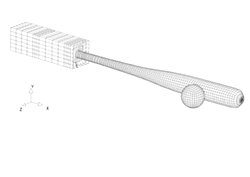Caring For A Wood Bat
Always hit with your wood bat with the label facing straight up.
As you stand in the batter’s box, check that you have a good grip and that you have the Buzzard Bat wood brand facing the sky. This way you will be making contact with the ball on the strongest part of the bat.
Bring your bat inside after your games and practices. Extreme temperature changes can impact the character of your bat’s wood. Do not leave your bat where it will experience extreme temperature changes, such as in your car or garage.
Clean your bat with a cloth after every game. Simply wiping down your bat will remove any dirt and moisture that may have built up over the course of a practice or game and can extend the life of your Buzzard Bat.
About the Ink Dot
In the early years of baseball, the bats were made from split hardwood logs by expert lumbermen and furniture makers. They knew that when a log is split, the wood splits along the direction of the wood fiber, giving the wood the optimal strength to absorb impact for tools like hammers and axe handles. This is also true for baseball bats.
Modern bat manufacturers often use sawed logs, rather than split, due to the technology needed to handle mass production for popular bat models. This is seen by some as a key factor in the increasing number of broken bat incidents in professional baseball, which has raised safety concerns for players and spectators.
MLB now insists that all bats used in professional play must now pass a slope of grain requirement. A simple ink-dot test is now performed at the 12″ mark on the tangential face of all Hard Maple, Yellow Birch and European Beech baseball bats. The ink dot is applied to the bare wood then lightly sanded in order to reveal the grain fiber alignment. The fiber must now be within 3 degrees of parallel to the longitudinal axis of the bat.
Hard Maple, Yellow Birch, and European Beech bats must be labeled on the radial grain side instead of the traditional tangential face used on Ash, Hickory and other ring- porous wood bats.
About Bone-Rubbing
“Bone rubbing” a bat is the process of compressing the surface layer of the wood fiber to reduce the chances of chipping or splintering. Originally this was done by physically pressing the bat down and sliding it across the curved surface of a large bone that could be obtained at any butcher shop or slaughterhouse.
These days, some players still bone-rub their bats, and when no bone is available, they use other hard surface materials such as porcelain toilets and sinks in the clubhouse. The ring-porous character of Ash wood makes it almost essential that some form of bone-rubbing is done on Ash bats. Whether this is done mechanically or by hand depends on the manufacturer.
Buzzard Bats made of Ash are bone-rubbed the way it’s been done for hundreds of years.
Comparing Wood Properties
The following information comes from www.wood-database.com. Below are descriptions of the three relevant properties relating to wood baseball bats and how the four most common woods used in baseball bat production measure up with each other.
Janka Hardness: This number is incredibly useful in directly determining how well a wood will withstand dents, dings, and wear—as well as indirectly predicting the difficulty in nailing, screwing, sanding, or sawing a given wood species. The actual number listed in the wood profile is the amount of pounds-force (lbf) or newtons (N) required to imbed a .444″ (11.28 mm) diameter steel ball into the wood to half the ball’s diameter. This number is given for wood that has been dried to a 12% moisture content, unless otherwise noted.
White Ash: 1,320 lbf (5,870 N) Hard Maple: 1,450 lbf (6,450 N)
Euro Beech: 1,450 lbf (6,460 N) Yellow Birch: 1,260 lbf (5,610 N)
Modulus of Rupture: Modulus of Rupture, frequently abbreviated as MOR, (sometimes referred to as bending strength), is a measure of a specimen’s strength before rupture. It can be used to determine a wood species’ overall strength; unlike the modulus of elasticity, which measures the wood’s deflection, but not its ultimate strength. (That is to say, some species of wood will bow under stress, but not easily break.) MOR is expressed in pounds-force per square inch (lbf/in2) or megapaschals (MPa). This number is given for wood that has been dried to a 12% moisture content, unless otherwise noted.
White Ash: 15,000 lbf/in2 (103.5 MPa) Hard Maple: 15,800 lbf/in2 (109.0 MPa)
Euro Beech: 15,970 lbf/in2 (110.1 MPa) Yellow Birch: 16,600 lbf/in2 (114.5 MPa)
Elasticity Modulus: In the simplest terms, the modulus of elasticity (MOE) measures a wood’s stiffness, and is a good overall indicator of its strength. Technically it’s a measurement of the ratio of stress placed upon the wood compared to the strain (deformation) that the wood exhibits along its length. MOE is expressed in pounds-force per square inch (lbf/in2) or gigapaschals (GPa). This number is given for wood that has been dried to a 12% moisture content, unless otherwise noted.
White Ash: 1,740,000 lbf/in2 (12.00 GPa) Hard Maple: 1,830,000 lbf/in2 (12.62 GPa)
Euro Beech: 2,075,000 lbf/in2 (14.31 GPa) Yellow Birch: 2,010,000 lbf/in2 (13.86 GPa)

